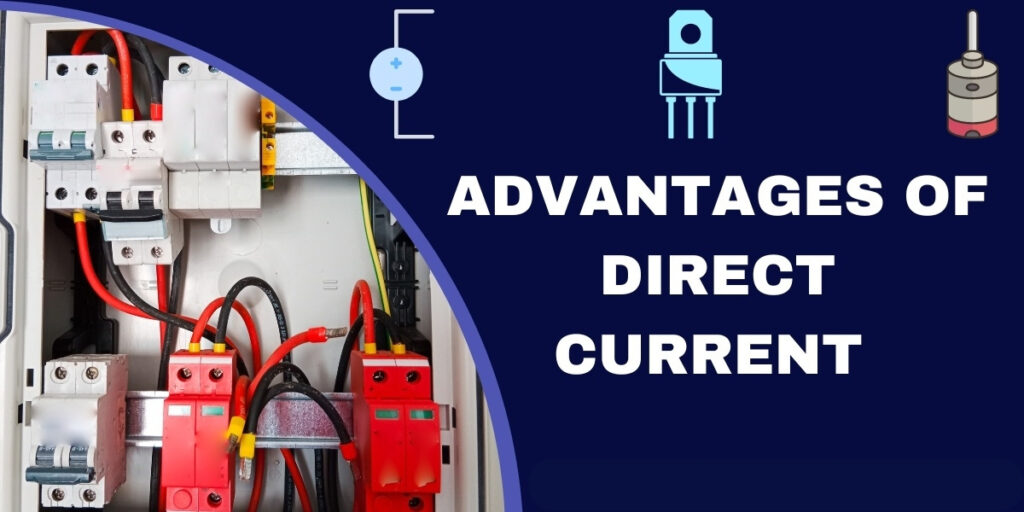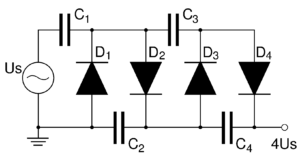

Advantages of Direct Current

In the vast realm of electrical power, two fundamental types exist: Direct Current (DC) and alternating current (AC). While alternating current has long been the dominant force in our power grids, Direct Current is making a steady comeback due to its numerous advantages in specific applications.
Direct Current (DC) is a steady and unswerving flow of electrical charges. Devices like rectifiers, batteries, fuel cells, and generators come equipped with commutators and produce DC. However, the retail industry found it uneconomical to convert DC to high voltages required for transmitting electricity over long distances. This led to an alternative – Alternating Current (AC), for commercial power transmission.
Later, techniques developed at that time paved the way for long-distance DC transmission, although it still needs to be converted into AC for local distribution. It finds its application in electronics, automotive systems, renewable energy, telecommunications, transportation, medical devices, research laboratories, and aerospace applications. Let’s explore more about the advantages of Direct Current in detail, along with its various types and how it is utilized in the commercial industry.
What is Direct Current?
The best Direct Current definition would be: Direct Current is a type of electrical current that flows in a constant direction without changing its polarity. In a DC circuit, the electric charge moves steadily from the positive terminal (anode) to the negative terminal (cathode) of a power source, such as a battery or a generator.
Unlike Alternating Current (AC), which periodically reverses its direction, Direct Current maintains a constant flow of electrons in one direction. The magnitude and polarity of DC remain constant over time, creating a stable and predictable electrical flow. Direct Current can be produced by converting AC power to DC using rectifiers or by generating it directly through sources like batteries, solar panels, fuel cells, or dynamos. DC is typically represented by a straight line on a graph, indicating a consistent flow of current.
In practical applications, Direct Current is used in various devices and systems, including electronics, telecommunications, automotive systems, renewable energy technologies, and many portable devices like laptops, smartphones, and electric vehicles. It also plays a crucial role in specific industrial processes, such as electroplating and electrolysis.
The best Direct Current definition would be: Direct Current is a type of electrical current that flows in a constant direction without changing its polarity. In a DC circuit, the electric charge moves steadily from the positive terminal (anode) to the negative terminal (cathode) of a power source, such as a battery or a generator.
Unlike Alternating Current (AC), which periodically reverses its direction, Direct Current maintains a constant flow of electrons in one direction. The magnitude and polarity of DC remain constant over time, creating a stable and predictable electrical flow. Direct Current can be produced by converting AC power to DC using rectifiers or by generating it directly through sources like batteries, solar panels, fuel cells, or dynamos. DC is typically represented by a straight line on a graph, indicating a consistent flow of current.
In practical applications, Direct Current is used in various devices and systems, including electronics, telecommunications, automotive systems, renewable energy technologies, and many portable devices like laptops, smartphones, and electric vehicles. It also plays a crucial role in specific industrial processes, such as electroplating and electrolysis.

Different Direct Current Types
Direct Current (DC) can be further classified into different Direct Current types based on their characteristics and applications. Here are a few types of Direct Current:
- Constant Current (CC)
- Constant Voltage (CV)
- Battery DC
- Pulsating DC
- HVDC (High-Voltage Direct Current)
Direct Current Frequency
The Direct Current frequency is 0 Hz, as the current only flows in one direction. Therefore, Direct Current (DC) does not have a frequency since it represents a constant flow of electric charge in a single direction. Frequency, by definition, refers to the number of cycles or oscillations per unit of time. In the case of DC, there are no oscillations or cycles because the current remains constant.
Frequency is associated with Alternating Current (AC), which changes its direction periodically. In an AC system, the frequency represents the number of complete cycles or oscillations that occur per second. In most power grids worldwide, the standard AC frequency is 50 or 60 hertz (Hz), indicating the number of cycles per second. So, while AC has a defined frequency, DC does not have a frequency as it does not oscillate or change direction over time.
Advantages of Direct Current
Direct Current (DC) has several advantages compared to alternating current (AC). Here are some of the key advantages of using Direct Current :
- Efficiency: Direct Current power transmission and distribution systems have higher efficiency compared to Alternating Current systems. When transmitting electricity over long distances, DC power experiences less line losses due to lower resistance. This makes DC suitable for high-voltage, long-distance transmission, such as in submarine cables and renewable energy projects.
- Renewable Energy Integration: Many renewable energy sources, such as solar panels and batteries, generate and store electricity in Direct Current form. Using DC power directly eliminates the need for conversion from DC to AC, which reduces energy losses and overall system complexity.
- Reduced Electrical Hazards: Direct Current systems generally pose lower risks of electrical shocks compared to Alternating Current systems. DC voltage does not cause the same level of muscular contractions and involuntary release of electrical contacts that AC voltage can cause. This makes DC safer for certain applications, such as in electric vehicles and certain industrial environments.
- Compatibility with Electronic Devices: Most electronic devices, such as computers, smartphones, and LED lights, operate internally on Direct Current power. Using DC directly eliminates the need for bulky Alternating Current-to-Direct Current converters or adapters, reducing energy losses and improving overall efficiency.
- Improved Power Quality Stability: Direct Current systems are ideal for those who desire a dependable and reliable power source as they offer improved stability in regards to power quality. AC power is vulnerable to voltage sags, harmonics, and additional disruptions, while DC power is significantly more resistant to such events. As a result, DC is typically implemented in delicate industrial machinery, as well as telecommunication systems and data centers.
- Modular and scalable : Direct Current systems can effectively accommodate a variety of energy sources for microgrids, energy storage systems, and distributed generation. Such adaptability makes them an ideal choice for both scaling up and down with ease.
Conclusion
Direct Current (DC) offers several advantages over Alternating current. Its key advantages include higher efficiency in power transmission and distribution, better compatibility with electronic devices, reduced electrical hazards, stability in power quality, scalability, and modularity. DC is particularly suitable for renewable energy integration, as many renewable sources generate and store electricity in DC form.
Direct Current is a widely utilized source of electric power in various fields. The constant and uninterrupted flow of electricity in a single direction prevents the need for converting alternating current to Direct Current while operating electronic devices on DC power.
While Alternating Current or AC power remains dominant in power grids and household electrical systems due to historical development and infrastructure compatibility, the importance of DC is growing, especially with the rise of renewable energy and the need for high-efficiency power transmission over long distances. We may see further advancements and innovations in applying Direct Current as technology advances.
FAQs
1. What is the difference between Direct Current (DC) and alternating current (AC)?
When comparing direct current (DC) and alternating current (AC), one of the main differences is the direction of current flow. In a DC circuit, electric charges move in only one direction, whereas in an AC circuit, the direction of current regularly shifts back and forth. Additionally, DC maintains a constant magnitude and polarity while AC changes both over time.
2. Can Direct Current be converted to alternating current?
Yes, Direct Current can be converted to alternating current using an inverter. An inverter converts DC to AC by periodically switching the polarity and magnitude of the DC voltage, producing an AC waveform.
3. What are the advantages of Direct Current over alternating current?
Direct Current has certain advantages over Alternating Current, including higher transmission and distribution efficiency, better compatibility with electronic devices, reduced electrical hazards, stability in power quality, and scalability for renewable energy integration. DC is also safer in specific applications eliminating the need for AC-to-DC conversion in devices that operate on DC power.